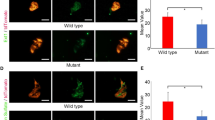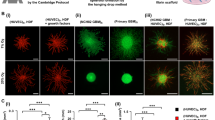Abstract
Transplantation of human cancers into immunologically deficient mice is widely used to study potential therapeutic interventions in vivo. For brain tumor research, however, several factors limit more widespread application of this animal model. First, only a minority of human glioma-derived cell lines are tumorigenic in nude mice. In addition, even for tumorigenic cell lines, tumor take is variable and growth is often slow for tumors derived from cell inoculums. Reconstituted components of tumor basement membrane (matrigel) have been found to improve the growth in nude mice of several types of human tumors originating outside the central nervous system when premixed with the tumor cells before subcutaneous inoculation. We investigated the ability of matrigel to enhance the growth in nude mice of tumors derived from the human glioma cell lines U-251 MG, U-373 MG, SNB-78 and SNB-101.
Athymic nude mice (NIH Swiss background, nu/nu genotype) were inoculated subcutaneously with 1.0 × 106 tumor cells alone or after premixing with an equal volume of liquid matrigel. U-251 and U-373 cells were tumorigenic, with palpable tumors present by about 2 to 3 weeks. Co-injection of these cell lines with matrigel resulted in higher tumor-take rates, from 6/10 to 8/8 animals for U-251 at 60 days, and from 9/12 to 11/11 animals for U-373 at 60 days. Matrigel also enhanced tumor growth, with tumors at 45 days significantly larger than those formed in the absence of matrigel, for both cell lines (p < 0.01). SNB-78 and SNB-101 cells did not give rise to progressively enlarging solid tumors with or without matrigel.
Matrigel enhances the growth of tumorigenic human gliomas in athymic nude mice. This technique provides a model with more consistent tumor take and more rapid growth kinetics for human glioma cell lines that are tumorigenic in nude mice.
Similar content being viewed by others
References
Goldin A: Screening at the National Cancer Institute: basic concepts. In: Hellman K, Carter SK (eds) Fundamentals of Cancer Chemotherapy. McGraw-Hill, New York, 1987, pp 141–148.
Rothenberg L, Terselic RA: Management of the National Cancer Institute's drug research program through application of the linear array concept. Cancer Chemother Rep 54: 303–310, 1970.
Venditti JM: Preclinical drug development: rationale and methods. Semin Oncol 54: 349–361, 1981.
Zubrod CG: Drug development at the National Cancer Institute: a historical perspective. In: Hellman K, Carter SK (eds) Fundamentals of Cancer Chemotherapy. McGraw-Hill, New York, 1987, pp 101–115.
Rubinstein LJ: Correlation of animal brain tumor models with human neuro-oncology. Nat Cancer Inst Monogr 46: 43–49, 1977.
Williams DE, Evans DMD, Blarney RW: The primary implantation of human tumours to the hamster cheek pouch. Br J Cancer 25: 533–537, 1971.
Fogh J, Tiso J, Orfeo T, Sharkey FE, Daniels WP, Fogh JM: Thirty-four lines of six human tumor categories established in nude mice. JNCI 64:745–751, 1980.
Giovanella BC, Stehlin JS, Williams LJ, Lee SS, Shepard RC: Heterotransplantation of human tumors into nude mice: a model system for human cancer chemotherapy. Cancer 42: 2269–2281, 1978.
Giovanella BC, Yim SO, Stehlin JS: Development of invasive tumors in the nude mouse after injection of cultured human melanoma cells. JNCI 48: 1531–1533, 1972.
Shimosato Y, Kameya T, Nagai K, Hirohashi S, Koide T, Hayashi H, Nomura T: Transplantation of human tumors in nude mice. JNCI 56: 1251–1260, 1976.
Bullard DE, S C Schold J, Bigner SH, Bigner DD: Growth and chemotherapeutic response in athymic mice of tumors arising from human glioma-derived cell lines. J Neuropathol Exp Neurol 40: 410–427, 1981.
Horten BC, Basler GA, Shapiro WR: Xenograft of human malignant glial tumors into brains of nude mice: a histopathological study. J Neuropathol Exp Neurol 40: 493–511, 1981.
Shapiro WR, Basler GA, Chernik NL, Posner JB: Human brain tumor transplantation into nude mice. JNCI 62: 447–453, 1979.
Fridman R, Giaccone G, Kanemoto T, Martin GR, Gazdar AF, Mulshine JL: Reconstituted basement membrane (matrigel) and laminin can enhance the tumorigenicity and the drug resistance of small cell lung cancer cell lines. Proc Natl Acad Sci USA 87: 6698–6702, 1990.
Fridman R, Kibbey MC, Royce LS, Zain M, Sweeney TM, Jicha DL, Yannelli JR, Martin GR, Kleinman HK: Enhanced tumor growth of both primary and established human and murine tumor cells in atymic mice after coinjection with matrigel. JNCI 83: 769–774, 1991.
Pretlow TG, Delmoro CM, Diley GG, Spadafora CS, Pretlow TP: Transplantation of human prostatic carcinoma into nude mice in matrigel. Cancer Res 51: 3814–3817, 1991.
Kleinman HK, Cannon FB, Laurie GW, Hassell JR, Aumailley M, Terranova VP, Martin GR, DuBois-Dalcq M: Biological activities of laminin. J Cell Biochem 27: 317–325, 1985.
Westermark B, Ponten J, Hugosson R: Determinants for the establishment of permanent tissue culture lines from human gliomas. Acta Pathol Microbiol Scand Sect A Pathol81: 791–805, 1973.
Wilson CB: Brain tumor models for experimental therapy. In: Laerum OD, Bigner DD, Rajewski MF (eds) Biology of Brain Tumors. UICC, Geneva, 1978, pp 185–199.
Russell DS, Rubinstein LJ: Pathology of Tumors of the Nervous System. Williams and Wilkins,1989.
Rygaard J, Povlsen CO: Heterotransplantation of a human malignant tumour to ‘nude’ mice. Acta Pathol Microbiol Scan 77: 758–760, 1969.
Ponten J, Maclntyre EH: Long term culture of normal and neoplastic human glia. Acta Pathol Microbiol Scand 74: 1968.
Rutka JT, Giblin JR, Dougherty DY, Liu HC, Bell CW, Stern RS, Wilson CB, Rosenblum ML: Establishment and characterization of five cell lines derived from human malignant gliomas. Acta Neuropathol (Berl) 75: 758–760, 1987.
Zietman AL, Suit HD, Ramsay JR, Silobrcic V, Sedlacek RS: Quantitative studies on the transplantability of murine and human tumors into the brain and subcutaneous tissues of NCr/Sed nude mice. Cancer Res 48: 6510–6516, 1988.
Jones TR, Bigner SH, Schold SC, Eng LF, Bigner DD: Anaplastic gliomas grown in athymic mice: morphology and glial fibrillary acidic protein expression. Am J Pathol 105: 316–327, 1981.
Maunoury R: Establishment and characterization of 5 human cell lines derived from a series of 50 primary intracranial tumors. Acta Neuropathol (Berl) 39: 33–41, 1977.
Rana MW, Pinkerton H, Thornton H, Nagy D: Heterotransplantation of human glioblastoma multiforme and meningioma to nude mice. Proc Soc Exp Biol Med 155: 85–88, 1977.
Edgar D, Timpl R, Thoenen H: The heparin-binding domain of laminin is responsible for its effect on neurite outgrowth and neuronal survival. EMBO J 3: 1463–1468, 1984.
Liotta LA, Goldfarb RH, Brundage R, Siegal GP, Terranova V, Garbisa S: Effect of plasminogen activator (urokinase), plasmin, and thrombin on glycoprotein and collagenous components of basement membrane. Cancer Res 41: 4629–4635, 1981.
Terranova VP, Rohrbach DH, Martin GR: Role of laminin in the attachment of PAM 212 (epithelial) cells to basement membrane collagen. Cell 22: 719–726, 1980.
Timpl R, Wiedemann H, vanDelden V, Furthmayr H, Kuhn K: A network model for the organization of type IV collagen molecules in basement membranes. Eur J Biochem 120: 203–211, 1981.
Yurchenco PD, Furthmayr H: Self assembly of basement membrane collagen. Biochemistry 23: 1839–1850, 1984.
Charonis AS, Tsilibary EC, Yurchenco PD: Binding of laminin to type IV collagen: a morphological study. J Cell Biol 100: 1848–1853, 1985.
Laurie GW, Bing JT, Kleinman HK, Hassell JR, Aumailley M, Martin GR, Feldmann RJ: Localization of binding sites for laminin, heparin sulfate proteoglycan and fibronectin on basement membrane (type IV) collagen. J Mol Biol 189: 205–216, 1986.
Woodley DT, Rao CN, Hassel JR, Liotta LA, Martin GR, Kleinman HK: Interactions of basement membrane components. Biochem Biophys Acta 761: 278–283, 1983.
Timpl R: Structure and biological activity of basement membrane proteins. Eur J Biochem 180: 487–502, 1989.
Farquhar MG: The glomerular basement membrane: a selective macromolecular filter. In: Hay ED (eds) Cell Biology of Extracellular Matrix. Plenum, New York, 1981, pp 365–462.
Author information
Authors and Affiliations
Additional information
The U.S. Government right to retain a non-exclusive, royalty free licence in and to any copyright is acknowledged
Rights and permissions
About this article
Cite this article
Akbasak, A., Toevs, C.C. & Laske, D.W. Reconstituted basement membrane (matrigel) enhances the growth of human glioma cell lines in nude mice. J Neuro-Oncol 27, 23–30 (1996). https://doi.org/10.1007/BF00146080
Issue Date:
DOI: https://doi.org/10.1007/BF00146080




